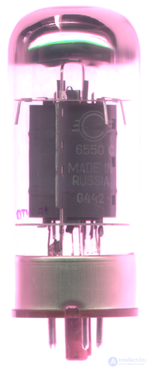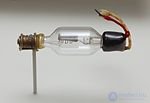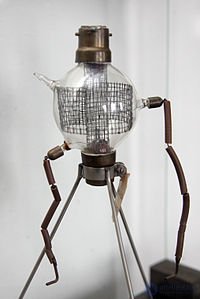Lecture

Russian export radio lamp 6550C
An electric lamp , a radio lamp is an electrovacuum device (more precisely, a vacuum electronic device), working by controlling the intensity of the flow of electrons moving in a vacuum or rarefied gas between the electrodes.
Radio tubes were massively used in the twentieth century as active elements of electronic equipment (amplifiers, generators, detectors, switches, etc.). Currently, almost completely replaced by semiconductor devices. Sometimes they are also used in high-power high-frequency transmitters and audio equipment.
Electronic lamps intended for illumination (flash lamps, xenon lamps, mercury and sodium lamps) are not called radio tubes and usually belong to the class of lighting devices.
Electron-beam devices are based on the same principles as radio tubes, but, in addition to controlling the intensity of the electron flow, also control the distribution of electrons in space and, therefore, are separated into a separate group. Also separately emit microwave microwave devices using resonant phenomena in the electron beam (such as a magnetron).
In vacuum tubes, the presence of gas degrades the characteristics of the lamp.
The main for this class of devices is the flow of ions and electrons in the gas that fills the lamp. The flow can be created, as in vacuum devices, by thermionic emission, or it can be created by the formation of an electrical discharge in a gas due to the intensity of the electric field.
The process of miniaturization of electronic vacuum tubes led to the rejection of heated cathodes and the transition to autoelectronic emission from cold cathodes of a special form from specially selected materials. [1] This makes it possible to bring the size of devices to micron sizes and use standard manufacturing processes of the semiconductor industry in their manufacture. [2] Currently, such constructions are being actively investigated.

The Triode ("Audion") of Lee de Foresta, 1906

The first Soviet radio lamp. Exposition of the Museum of Novgorod Radio Laboratory
In 1883, Edison tried to increase the service life of a carbon filament lighting lamp in a vacuum glass flask. To this end, in one of the experiments, he introduced a metal plate with a conductor bred out into the vacuum space of the lamp. During the experiments, he noticed that the vacuum conducts current, and only in the direction from the electrode to the heated thread and only when the thread is heated. It was unexpected for that time - it was believed that the vacuum can not conduct current, since there are no charge carriers in it. The inventor did not understand then the significance of this discovery, but, just in case, he patented it.
Thanks to these experiments, Edison became the author of a fundamental scientific discovery, which is the basis for the operation of all electron tubes and all electronics before creating semiconductor devices. Subsequently, this phenomenon is called thermionic emission.
In 1905, this “Edison effect” became the basis of the British patent by John Fleming on “a device for converting alternating current into direct current” - the first electronic lamp that opened the age of electronics. [ source not specified 1943 days ]
In 1906, American engineer Lee de Forest introduced a third electrode into the lamp - a control grid (and thus created a triode). Such a lamp could already work as a current amplifier, and in 1913 an autogenerator was created on its basis.
In 1921, A. A. Chernyshev [3] [4] proposed the design of a cylindrical heated cathode (indirectly heated cathode).
Miniature rod pentodes produced in the USSR
Vacuum electronic lamps became the element base of computers of the first generation. The main disadvantage of electronic lamps was that devices based on them were rather cumbersome. To supply the lamps, it was necessary to supply additional energy to heat the cathode (it is it that emits the electrons necessary for the current in the lamp), and the heat generated by them is removed. For example, in the first computers thousands of lamps were used that were placed in metal cabinets and took up a lot of space. Weighed such a machine tens of tons. For her work required power. To cool the car used powerful fans in connection with the release of lamps huge amounts of heat.
The peak of the heyday (“golden era”) of lamp circuitry fell on the years 1935-1950.

Elements of the electronic lamp (pentode):
Filament, cathode, three grids, anode. Above - fasteners and a ring with an air residue absorber.
Electron tubes have two or more electrodes: cathode , anode and grid .
In order to ensure the emission of electrons from the cathode, it is additionally heated [3] .
According to the method of heating, the cathodes are divided into cathodes of direct and indirect heat.
The direct-heated cathode is a metallic filament made of metal with high electrical resistivity. Direct-heat lamps require less power, heat up faster, there is no problem of providing electrical insulation between the cathode and the filament (this problem is significant in high-voltage kenotrons). However, they usually have a shorter service life; when used in signal circuits, they need to be powered by direct current, and in a number of schemes they are not applicable due to the effect of potential difference in different parts of the cathode on the lamp operation.
The indirectly heated cathode is a cylinder, inside which a filament (heater) is placed. Such lamps are called indirect lamps.
To facilitate the emission of electrons, the cathodes of the lamps are usually activated — they are coated with a thin layer of a substance having a relatively small work function: thorium, barium, and their compounds [5] . The activating layer in the process of work is gradually destroyed and the lamp loses its emission. Purely metal cathodes (for example, in high-power lamps with a high cathode current density) are made of tungsten.

Electron tube anode
Positive electrode It is sometimes performed in the form of a plate, but more often in the form of a box surrounding the cathode and the grid and having the shape of a cylinder or parallelepiped. In high-power lamps, the anode can have ribs or “wings” to remove heat. It is usually made from nickel or molybdenum, sometimes from tantalum and graphite.
Between the cathode and the anode are grids that serve to control the flow of electrons and eliminate side effects that occur when electrons move from the cathode to the anode.
The grid is a grid of thin wire, or more often made in the form of a wire helix, wound on several supporting racks (traverse). In rod lamps, the role of grids is performed by a system of several thin rods parallel to the cathode and anode, and the physics of their work is different than in the traditional design.
By appointment, the grids are divided into the following types:
Depending on the purpose of the lamp, it can have up to seven grids. In some embodiments of switching on multigrid lamps, separate grids can act as an anode. For example, in a generator according to the Schembel scheme on a tetrode or pentode, the generator itself is a “virtual” triode formed by the cathode, the control grid and the screening grid as the anode [6] [7] .
The brilliant sputtering (getter), which can be seen on the glass of most electron tubes, performs a dual function - the residual gas adsorbent, as well as a vacuum indicator (many types of getter turn white when air enters the lamp if it is damaged).
Metal electrodes (current leads) passing through the glass body of the lamp must be matched in terms of the coefficient of thermal expansion with this brand of glass and well moistened with molten glass. They are made of platinum (rarely), platinite, molybdenum, etc. [8]
Compact ("finger") radio tubes
The main types of electronic vacuum tubes:
Ceramic-metal generating triode GS-9B with air cooling (USSR)
Due to the principle of operation, electronic lamps are devices that are much more resistant to such damaging factors as the electromagnetic pulse. In a single device there may be several hundred lamps. In the USSR, rod lamps were used for use in onboard military equipment in the 1950s, which were distinguished by their small size and high mechanical strength.

Miniature lamp type "acorn" (pentode 6ZH1ZH, USSR, 1955).
The radiation degradation of semiconductor materials and the presence of the natural vacuum of the interplanetary medium makes the use of certain types of lamps a means of improving the reliability and durability of spacecraft. Application in AMSLuna-3 transistors was associated with great risk. [9]
Lamp equipment can be designed for a larger temperature and radiation range of conditions than semiconductor.
Main article: Tube Sound
Electron tubes are still used in sound engineering, both amateur and professional. Designing tube sound engineering devices is one of the directions of the modern amateur radio movement.
In Europe in the 1930s, the leading manufacturers of radio tubes adopted the Common European system of alphanumeric marking:
- The first letter characterizes the filament voltage or its current:
A - voltage of 4 V;
B - filament current 180 mA;
C - filament current 200 mA;
D - filament voltage up to 1.4 V;
E is the filament voltage of 6.3 V;
F - voltage of 12.6 V;
G is the filament voltage of 5 V;
H - filament current 150 mA;
K - filament voltage 2 V;
P - filament current 300 mA;
U - filament current 100 mA;
V - heat current 50 mA;
X - heating current 600 mA.
- The second and subsequent letters in the designation determine the type of lamps:
A - diodes;
B - double diodes (with common cathode);
C - triodes (except weekends);
D - output triodes;
E - tetrodes (except weekends);
F - pentodes (except weekends);
L - output pentodes and tetrodes;
H - hexodes or heptodes (hexode type);
K - octodes or heptodes (octode type);
M - electronic and indicator lights settings;
P - amplifier lamps with secondary emission;
Y - half-wave kenotrons (simple);
Z - full-wave Kenotrons.
- A two-digit or three-digit number indicates the exterior design of the lamp and a serial number of this type, with the first digit usually characterizing the type of base or leg, for example:
1-9 - glass lamps with lamella base (“red series”)
1x - lamps with an eight-pin base ("11-series")
3x - lamps in a glass cylinder with an octal base;
5x - lamps with an octal base;
6x and 7x - glass subminiature lamps;
8x and from 180 to 189 - glass miniature with a nine-pin foot;
9x - glass miniature with a seven-pin leg.

Tiratron
Discharge lamps typically use discharge in inert gases at low pressures. Examples of gas discharge tubes:
Comments
To leave a comment
Radio tubes and ion devices
Terms: Radio tubes and ion devices